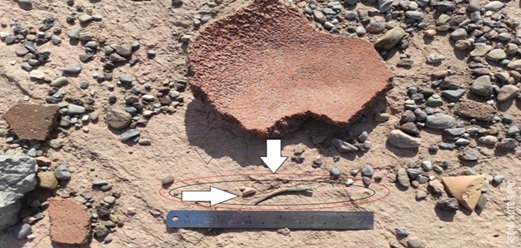Traces of Bronze Age smelting workshops discovered in southern Iran

TEHRAN – Archaeologists have found new traces of metal smelting workshops, estimated to date from the Bronze Age, in the Shahdad region of Kerman province, southern Iran.
“During this survey, we came across old metal smelting sites, which shows the concentration of industrial activities in Shahdad,” CHTN quoted Iranian archaeologist Soraya Elikai-Dehno as saying on Saturday.
Supervised by the Research Institute for Cultural Heritage and Tourism (RICHT), the research was conducted in the Shahdad region situated inside the UNESCO-registered Lut desert, the report said.
“Abundant evidence concerning the (ruined) structures of metal smelting workshops has come to light…. The discovery suggests that ancient Kerman was an important hub for metalworking as one of the oldest centers of bronze production due to its special location and environmental conditions.”
The official expressed hope to establish a site museum for showcasing those traditional metal smelting workshops and their associated cultural heritage in the near future, CHTN reported.
“The existence of mines, and the technical diversity of metal objects in the Bronze Age, is indicative of the progress of the metalworking industry in this cultural field… Moreover, the existence of residual waste from the metal melting process proves this claim,” the archaeologist explained.
“During this survey, we came across old metal smelting sites, which shows the concentration of industrial activities in this part of Shahdad.”
“On the surface of the surveyed area, which is located about 1.5 km east of Shahdad city on the western edge of Lut desert, the scattering of historical and cultural evidence such as copper smelting slags, copper objects, stone tools, and pottery pieces dating from prehistorical times to the beginning of urbanization can be seen,” Elikai-Dehno said.
According to the book “On Salt, Copper, and Gold” by archaeologists Catherine Marro and Thomas Stollner, the highlands of Iran, with their rich mineral resources, have long been known as one of the hotspots of early metallurgy.
“The foundation of the first urban sites in the late 4th millennium BC correlates with a quantum leap in metallurgical technology that became possible through the introduction of updraft furnaces. From that moment onwards, we can also observe experimentation in the production of various alloys such as arsenic copper. Surprisingly, tin bronze is introduced to highland Iran only in the 2nd millennium BC,” parts of the book read.
The mining areas, which are widely known in Iran, can rarely be dated, therefore establishing the beginning of opencast and underground mine exploitation remains a problem; however, at the latest from the Bronze Age onwards, underground shafts were used to obtain the desired materials.
Rounds of research have provided robust data that afford a more precise chronological but also a geographical distinction between the various strands of development, which differ according to regional “schools”. Long-distance exchanges of knowledge and objects only occur from the late 4th millennium BC onwards with the inclusion of the Iranian highlands into a network of urban sites.
Due to its rich natural resources, which comprise large bodies of metal ores, Iran has always been considered a major supplier of metal to the early states of Mesopotamia and its neighbors, the book says.
However, from about 6000 BC onwards, metallic copper had been used in Iranian Late Neolithic communities to shape reamers, points, and hooks through mechanical working and annealing. Copper objects are reported from various places in all areas of Iran.
With the onset of the 4th millennium BC, smelting copper becomes a regular craft activity among the Chalcolithic communities of highland Iran. The best evidence comes from the Central Plateau where sites cluster in environmentally favorable locations around major springs. Settlements grow larger over the first centuries of the 4th millennium BC and internal differentiation between individual buildings becomes more apparent.
Shahdad is home to shifting sands, salt plains, meteorite fields, and rocky terrain, which offers visitors breathtaking vistas and unparalleled serenity of the intact nature and wilderness. It has long been a destination for adventurers, nature lovers, off-roaders, and trekkers.
The Lut Desert, widely referred to as Dasht-e Lut (“Emptiness Plain”), is a large salt desert encircled by the provinces of Kerman and Sistan- Baluchestan, and South Khorasan. The desert is also considered one of the top areas in the world for finding meteorites, thanks to its unique parameters. In recent years, significant finds have been made, with the efforts of national and international teams of researchers.
AFM
Leave a Comment